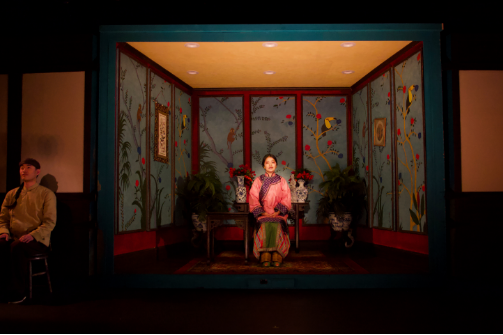
The Chinese Lady
By Lloyd Suh; Directed by Ralph B. Peña
Produced by Ma-Yi Theater Company, with Barrington Stage Company
Off Broadway, Play
Ran through 11.18.18
Theater Row, 410 West 42nd Street
by Ran Xia on 11.26.18
 Daniel K. Isaac and Shannon Tyo in The Chinese Lady. Photo by Eloy Garcia.
Daniel K. Isaac and Shannon Tyo in The Chinese Lady. Photo by Eloy Garcia.
BOTTOM LINE: American history seen through the life story of a Chinese woman who was forced to become a totem of her time.
Turn around a shipping container, open it up to review a simulated Chinese room filled with ornate rosewood furniture, blue floral vases, silk wall hangings, everything you’d expect to be “Oriental.” A woman is on display for your education and entertainment; she says it herself, in a pleasant demeanor, dressed to the nines in what’s considered the most traditional of Chinese costumes. She is assisted by a translator, who, as a character note, does not matter.
The Chinese Lady is the story of Afong Moy (Shannon Tyo), the first documented Asian woman to set foot on American soil. Born in 1820, she was 14 years old when she became a tourist attraction, and perhaps remained one for the rest of her life. Her journey, or shall we say stardom, began in 1834 at Carne Brothers Museum, where, for 25 cents per adult and 10 cents per child, people from everywhere get to see her being “exotic, foreign, and unusual.” This exoticism is a highly choreographed routine. Afong would sit for 5 minutes, then walk around the room to show off her bound feet; then she’d eat: Chinese vegetables and steamed shrimp, (the same food with little variation every day) with a pot of tea.
Afong Moy's joyful demeanor endears her to the audience easily. Tyo commands the stage with ease and captures your attention even without moving a muscle. Both she and Daniel Isaac, as the translator Atung, are marvelous, as they portray their elevated characters with gravitas and, even in the most exaggerated moments, never sink into caricature.
Playwright Lloyd Suh has crafted fully believable characters in this true story. The youthful foreign import embraces her new life with enthusiasm at first. She enjoys being seen; she relishes the process of demonstrating the use of chopsticks: “Forks are violent and easy. Chopsticks are elegant and poetic,” she says, after experiencing American utensils with her host family. And it is all very genuine, for of course it’d be exciting for a 14-year-old who’s never set foot outside of her hometown. As her fame grows, she journeys across America and develops an idea: she’s going to return to China with a white girl, who will be able to see China the way Afong is seeing America. Of course, that’s a pipe dream of an innocent, who is yet to understand that people's curious gazes aren't always benign.
Directed by Ralph B. Peña, the play is elegantly spaced and strictly chronological. Each scene resets to the top of Afong’s hour-long demonstration: this doesn’t change however many years we jump forward in time, and however much Afong has matured as an adult. She is perpetually perceived as simple minded, exotic lady whose value does not exceed offering an immaculate cultural performance. Still, she embraces her newfound status as a celebrity and considers it a testament to humans’ curiosity about other places in the world. However, her desire for cultural exchange is cruelly diminished by her circumstances, which the playwright ingeniously demonstrates: in a cringeworthy scene, Afong recounts her meeting with President Andrew Jackson. The conversation, recreated by Atung and Afong, is painful to witness, as we watch Afong’s elegant speech disintegrate, losing all its nuance in translation, stripped down to the clumsy, simplistic English Atung is capable of. Speaking of Atung, he is a perfect peg for the tragic role Asian men are forced to take on. We are constantly reminded that he does not matter, and through him, the play effectively addresses the issue of the erasure of Asian men in mainstream culture.
The Chinese Lady traces Afung’s transformation through the years: she grows to be more sophisticated, and assimilates to American culture to the point of losing her mother tongue. And that’s a familiar tale, isn’t it? An immigrant arrives with reverence for this country, an acquired love and patriotism that is no less than those of a born citizen, if not stronger. And yet, they are often rejected because of the color of their skin, the way they speak, and the sound of their names. Afung Moy spends the entire play in a gilded cage created for one purpose: for her to be seen, to be an object of curiosity. Although what we are shown is an isolated woman, what we really see is America through a unique lens.
I felt there was too much sentimentality in the final moments of the play, and got slightly confused by somewhat unnecessary faux endings. But they do not take away the impact from this captivating story. The Chinese Lady is a masterpiece in the making. It takes us on an emotional journey through American history, and its masterfully developed characters will stay with you for years to come.
(The Chinese Lady played at Theater Row, 410 West 42nd Street, through November 18, 2018. The running time was 1 hour and 30 minutes with no intermission. For more information visit ma-yitheatre.org.)
The Chinese Lady is by Lloyd Suh. Directed by Ralph B. Peña. Scenic and Costume Design by Junghyun Georgia Lee. Lighting Design by Oliver Wason. Sound Design by Fabian Obispo. Production Stage Manager is Geoff Boronda.
The cast is Shannon Tyo and Daniel K. Isaac.

